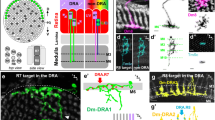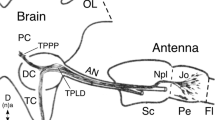Summary
The structure of ommatidia at the dorsal eye margin of the fly, Calliphora erythrocephala is specialized for the detection of the e-vector of polarized light. Marginal zone ommatidia are distinguished by R7/R8 receptor cells with large-diameter, short, untwisted rhabdomeres and long axons to the medulla. The arrangement of the R7 microvillar directions along the marginal zone is fan-shaped. Ommatidia lining the dorsal and frontal edge of the eye lack primary screening pigments and have foreshortened crystalline cones. The marginal ommatidia from each eye view a strip that is 5 °–20 ° contralateral to the fly's longitudinal axis and that coincides with the outer boundaries of the binocular overlap.
Cobalt injection into the retina demonstrates that photoreceptor axons arising from marginal ommatidia define a special area of marginal neuropil in the second visual neuropil, the medulla. Small-field neurons arising from the marginal medulla area define, in turn, a special area of marginal neuropil in the two deepest visual neuropils, the lobula and the lobula plate. From these arise local assemblies of columnar neurons that relay the marginal zones of one optic lobe to equivalent areas of the opposite lobe and to midbrain regions from which arise descending neurons destined for the the thoracic ganglia.
Optically, the marginal zone of the retina represents the lateral edge of a larger area of ommatidia involved in dorsofrontal binocular overlap. This binocularity area is also represented by special arrangements of columnar neurons, which map the binocularity area of one eye into the lobula beneath the opposite eye. Another type of binocularity neuron terminates in the midbrain.
These neuronal arrangements suggest two novel features of the insect optic lobes and brain: (1) Marginal neurons that directly connect the left and right optic lobes imply that each lobe receives a common input from areas of the left and right eye, specialized for detecting the pattern of polarized light. (2) Information about the e-vector pattern of sky-light polarization may be integrated with binocular and monocular pathways at the level of descending neurons leading to thoracic motor neuropil.
Similar content being viewed by others
References
Autrum H (1949) Neue Versuche zum optischen Auflösungsvermögen fliegender Insekten. Experientia 39:290–297
Bacon JP, Altman JS (1977) A silver intensification method for cobalt-filled neurons in wholemount preparations. Brain Res 138:359–363
Beersma DGM, Stavenga DG, Kuiper JW (1975) Organization of visual axes in the compound eye of the fly Musca domestica L and the behavioural consequences. J Comp Physiol 102:305–320
Braitenberg V (1967) Patterns of projections in the visual system of the fly. I. Retina-lamina projections. Exp Brain Res 3:271–298
Braitenberg V (1972) Periodic structures and structural gradients in the visual ganglia of the fly. In: Wehner R (ed) Information processing in the visual system of arthropods. Springer, Berlin Heidelberg New York, pp 1–15
Burghause FM (1979) Die strukturelle Spezialisierung des dorsalen Augenteils der Grillen (Orthoptera, Grylloidea). Zool Jahrb Physiol 83:502–525
Campos-Ortega JA, Strausfeld NJ (1972) The columnar organization of the second synaptic region of the visual system of Musca domestica. L. I. Receptor terminals in the medulla. Z Zellforsch 124:561–585
Clark G (1973) Neurological staining methods: Bodian's protargol method. In: Clark G (ed) Staining procedures used by the Biological Stain Commission. Williams and Wilkins, Baltimore, pp 98–100
Collett TS, Cartwright BA (1983) Eidetic images in insects: Their role in navigation. Trends Neurosci 3:101–105
Duelli P (1972) The relation of astromenotactic and anemomenotactic orientation mechanism in desert ants, Cataglyphis bicolor (Formicidae, Hymenoptera). In: Wehner R (ed) Information processing in the visual systems of arthropods. Springer, Berlin Heidelberg New York, pp 281–286
Duelli P (1975) A fovea for e-vector detection in the eye of Cataglyphis bicolor (Formicidae, Hymenoptera). J Comp Physiol 102:43–56
Duve H, Thorpe A, Strausfeld NJ (1983) Cobalt-immunocytochemical identification of peptidergic neurons in Calliphora innervating central and peripheral targets. J Neurocytol 12:847–861
Franceschini N (1975) Sampling of the visual environment by the compound eye of the fly: Fundamentals and applications. In: Snyder AW, Menzel R (eds) Photoreceptor optics. Springer, Berlin Heidelberg New York, pp 98–125
Franceschini N, Kirschfeld K (1971a) Les phenomènes de pseudopupille dans l'oeil compose de Drosophila. Kybernetik 9:159–182
Franceschini N, Kirschfeld K (1971b) Étude optique in vivo des elements photorecepteurs dans l'oeil compose de Drosophila. Kybernetik 8:1–13
Frisch K von (1949) Die Polarisation des Himmelslichtes als orientierender Faktor bei den Tänzen der Bienen. Experientia 5:142–148
Frisch K von (1965) Tanzsprache und Orientierung der Bienen. Springer, Berlin Heidelberg New York
Glauert AM (1974) Practical methods in electron microscopy, vol 3. North Holland, Amsterdam
Hardie RC (1983) Projection and connectivity of sex-specific photoreceptors in the compound eye of the male housefly (Musca domestica). Cell Tissue Res 233:1–21
Hardie RC (1984) Properties of photoreceptors R7 and R8 in dorsal marginal ommatidia in the compound eyes of Musca and Calliphora. J Comp Physiol 154:157–165
Hausen K (1981) Monocular and binocular computation of motion in the lobula plate of the fly. Verh Dtsch Zool Ges 75:49–70
Hausen K, Strausfeld NJ (1980) Sexually dimorphic interneuron arrangements in the fly visual system. Proc R Soc Lond B 208:57–71
Kirschfeld K, Reichardt W (1970) Optomotorische Versuche an Musca mit linear polarisiertem Licht. Z Naturforsch 256:228
Labhart T (1980) Specialized photoreceptors at the dorsal rim of the honeybee's compound eye: Polarizational and angular sensitivity. J Comp Physiol 141:19–30
Menzel R (1976) Polarized light sensitivity in arthropods. In: Evans GC, Bainbridge R, Rackham O (eds) Light as an ecological factor: II. Blackwell, Oxford, pp 289–303
Menzel R, Blakers M (1976) Colour receptors in the bee eye: Morphology and spectral sensitivity. J Comp Physiol 108:11–33
Meyer ER (1984) Retrograde labelling of photoreceptors in different regions of the compound eyes of bees and ants. J Neurocytol 13:825–836
Meyer EP, Labhart T (1983) Pore canals in the cornea of a functionally specialized area of the honey bee's compound eye. Cell Tissue Res 216:491–501
Millonig G (1961) Advantages of a phosphate buffer for OsO4 solutions in fixation. J Appl Physiol 32:1637
Rossel S, Wehner R (1982) The bee's map of the e-vector pattern in the sky. Proc Natl Acad Sci USA 79:4451–4455
Rossel S, Wehner R, Lindauer M (1978) E-vector orientation in bees. J Comp Physiol 125:1–12
Schinz RH (1975) Structural specialization in the dorsal retina of the bee, Apis mellifera. Cell Tissue Res 162:23–34
Sommer EW (1979) Untersuchungen zur topografischen Anatomie der Retina und zur Sehfeldtopologie im Auge der Honigbiene, Apis mellifera (Hymenoptera). PhD thesis, Univ Zürich
Stephens GC, Fingerman M, Brown FA (1953) The orientation of Drosophila to plane polarized light. Ann Entomol Soc Amer 46:75–83
Strausfeld NJ (1970) Golgi studies on insects. II. The optic lobes of Diptera. Phil Trans Roy Soc Lond 258:135–223
Strausfeld NJ (1971) The organization of the insect visual system (light microscopy). II. The projection of fibres across the first optic chiasma. Z Zellforsch 121:442–454
Strausfeld NJ (1979) The representation of a receptor map within retinotopic neuropil of the fly. Verh Dtsch Zool Ges 72:167–179
Strausfeld NJ (1980) Male and female visual neurones in dipterous insects. Nature 283:381–383
Strausfeld NJ (1984) Functional neuroanatomy of the blowfly's visual system. In: Ali MA (ed) Photoreception and vision in invertebrates. Plenum, New York, pp 483–522
Strausfeld NJ, Bacon JP (1983) Multimodal convergence in the central nervous system of dipterous insects. In: Horn E (ed) Multimodal convergence in sensory systems. Gustav Fischer, Stuttgart, pp 47–76
Strausfeld NJ, Bassemir UK (1983) Cobalt-coupled neurons of a giant fibre system in Diptera. J Neurocytol 12:971–991
Strausfeld NJ, Hausen K (1977) The resolution of neuronal assemblies after cobalt injection into neuropil. Proc R Soc Lond B 199:463–476
Strausfeld NJ, Obermeyer M (1976) Resolution of intraneuronal and transsynaptic migration of cobalt in the insect visual and central nervous systems. J Comp Physiol 110:1–12
Strausfeld NJ, Seyan HS (1985) Convergence of visual, haltere and prosternal inputs at neck motor neurons of Calliphora. Cell Tissue Res 240:601–615
Thorpe WH (1949) Orientation and methods of communication of the honey bee and its sensitivity to the polarization of the light. Nature 164:11
Trujillo-Cenoz O (1966) Some aspects of the structural organization of the intermediate retina of dipterans. J Ultrastruct Res 13:1–33
Venable JH, Coggeshall R (1965) A simplified lead citrate stain for use in electron microscopy. J Cell Biol 25:407–408
Wada S (1974a) Spezielle randzonale Ommatidien der Fliegen (Diptera: Brachycera): Architektur und Verteilung in den Komplexaugen. Z Morphol Tiere 77:87–125
Wada S (1974b) Spezielle randzonale Ommatidien von Calliphora erythrocephala (Diptera: Calliphoridae): Architektur der zentralen Rhabdomeren-Kolumne und Topographie im Komplexauge. Int J Insect Morphol Embryol 3:397–424
Wehner R (1983) Celestial and terrestrial navigations: Human strategies — insect strategies. In: Huber F, Markl H (eds) Neuroethology and behavioural physiology. Springer, Berlin Heidelberg New York, pp 366–381
Wehner R, Duelli P (1971) The spatial orientation of desert ants, Cataglyphis bicolor. Experientia 27:1364–1366
Wehner R, Lanfranconi B (1981) What do the ants know about the rotation of the sky? Nature 293:731–733
West LS (1951) The house fly. Comstock, Ithaca
Wolf R, Gebhardt B, Gademann R, Heisenberg M (1980) Polarization sensitivity of course control in Drosophila melanogaster. J Comp Physiol 139:177–191
Wunderer H, Smola U (1982a) Fine structure of ommatidia at the dorsal eye margin of Calliphora erythrocephala Meigen (Diptera: Calliphoridae): An eye region specialised for the detection of polarized light. Int J Insect Morphol Embryol 11:25–38
Wunderer H, Smola U (1982b) Morphological differentiation of the central visual cells R7/R8 in various regions of blowfly eye. Tissue Cell 14:341–358
Author information
Authors and Affiliations
Rights and permissions
About this article
Cite this article
Strausfeld, N.J., Wunderer, H. Optic lobe projections of marginal ommatidia in Calliphora erythrocephala specialized for detecting polarized light. Cell Tissue Res. 242, 163–178 (1985). https://doi.org/10.1007/BF00225573
Accepted:
Issue Date:
DOI: https://doi.org/10.1007/BF00225573




